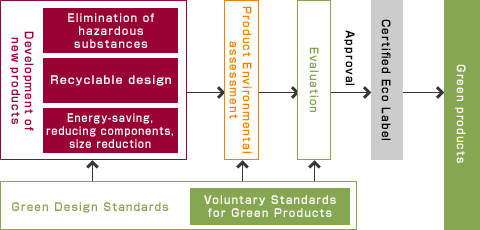 Green Products
Green Products
Approach to Materiality in Products and Services
Advantest products generate various small and large environmental impacts through their use. Green products, which reduce environmental impact, are important part for us not only because they address environmental issues but also to appeal quality of our products.
| Supervising division | CSR & Environmental Affairs Promotion Office |
|---|---|
| KPI | Ratio of products that clear our voluntary standards for green products |
| FY2018 target | 100% |
| FY2016 result | 100% |
| Boundary (scope) | Advantest Corporation (non-consolidated) in Japan |
| Relevant policies | Advantest Group Environmental Policy |
| Relevant commitments | Our voluntary standards for green products follow the ISO14021 even though they are not direct compliance targets. |
| Responsible department/division | CSR & Environmental Affairs Promotion Center/Environmental Management Officer |
| Relevant complaint processing policy | ― |
| Assessment | Good |
Basic Stance
Contributing to the sustainable development of society and conducting environmentally-friendly business operations are essential issues that need to be addressed in modern business management. The Advantest Group works to develop products from the perspective of environmental conservation while prioritizing high precision and high quality, and certifies as green products those products that are environmentally-friendly in terms of the three key aspects of energy and resource saving, improving recyclability, and elimination of hazardous substances. There is demand in society for the supply of green products because they provide both a reduction in the environmental footprint and an improvement in economic value. The Advantest Group is developing green products in response to these demands and based on the belief that these products will be beneficial for its customers.
Development Flow of Green Products
At the Advantest Group, all new products undergo a product environmental assessment.
During the product environmental assessment, products are assessed from various aspects, including energy-saving, reducing components, size reduction, recyclable design, and elimination of hazardous substances. Products that meet the Voluntary Standards for Green Products defined by Advantest are certified as green products and are awarded with an Eco Label (type II).
Development flow of green products

Advantest Group Eco Label
The Advantest Group Eco Label features an original three-color design representing energy and resource saving, recyclable design, and elimination of hazardous substances through green procurement.
Energy and Resource Saving
Voluntary Standards
- Energy saving design
- Reducing component design
- Size reduction design
Recyclable Design
Voluntary Standards
- Design with recyclable plastic materials
- Design for ease of disassembly
- Release of information on disposal

Elimination of hazardous substances
(Green Procurement)
Voluntary Standards
- Improved rates of green procurement
- Elimination of banned substances
Energy and Resource Saving
We aim to reduce the environmental impact of our products through product designs with energy savings, reducing components, and size reduction .
Recyclable Design
In recyclable design, we release information on parts that will require special attention during disposal, and plastic parts designed in-house use 90% or more recyclable materials. Moreover, we make sure that products are easy to dismantle with standard tools, and we use rechargeable batteries displaying a recycling symbol.
Elimination of Hazardous Substances (Green Procurement)
To eliminate hazardous substances from our products, we have established Group standards on banned substances based on the IEC 62474 standard, and we conduct surveys of hazardous substances contained in parts and materials used in our products.
Green Products Certified during Fiscal 2016
We supplied the following products, which were certified as green products in fiscal 2016.
- T5830 Memory Test System
- T5851 Memory Test System
- T5851ES Memory Test System
- T5821 Memory Test System
- T2000 AiR SoC Test System
- M6245 X64ATC Test Handler
- Thermal Hand Plug Unit M4871ES
- HA7200 Temperature and Pressure Unit
- Die Level Handler HA1000L
| New Product model | Versus previous product | Energy efficiency improvement (%) | Reduction in components rate (%) | Reduction in size rate (%) |
|---|---|---|---|---|
| T5830 | T5781 | 81 | 79 | 81 |
| T5851 | T5831 | 86 | 88 | 88 |
| T5851ES | T5831ES | 84 | 88 | 88 |
| T5821 | T5386 | 32 | 49 | 19 |
| T2000 AiR | T2000 GSMF+13TH | 84 | 86 | 85 |
Note: The reduction rates given above are the values resulting from the performance conversion.
Introducing One of Advantest’s Green Products
T2000 AiR Test System
T2000 AiR Test System
Online services for residential and industrial services grow as smartphones and mobile devices become more prevalent. Integrated devices and modules such as System in Package (SiP) that combines multiple functions from communications to power management and sensors into micro controllers and application processes is expected to enter many markets in the future for these services.
T2000 AiR is the optimal small air cooling system for developing these devices and modules as well as for multiple small‐volume production. Equipment to supply water for cooling is not required in addition to the small size for storing in the tester connection space of our M48xx-series Test Handler. We are proposing the connections of these handlers as Integrated Zero Test Stations.
The T2000 AiR offers four times the system bus speed through an Enhanced Performance Package (EPP) response compared to the T2000 GSMF to realize 84% less power consumption with comparable performance and 85% more miniaturization.
We also offer a line-up of 15 or more different types of air cooling measurement modules for the T2000 AiR, which contribute to timely market penetration of products for customers. The same software environment is viable as is with the T2000 series’ high expandability for measuring multiple devices simultaneously when transitioning to mass production.





